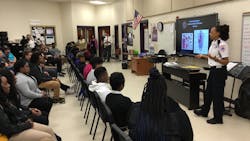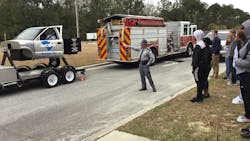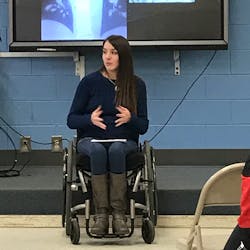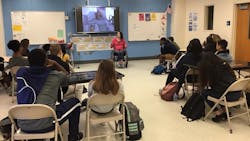Firefighters come into this profession to serve their community, to save lives and to make a difference. However, it doesn’t take them long to realize that civilians’ lives are at risk of being irreversibly altered despite the firefighters’ incredible and admirable response to emergencies. From the moment that an emergency event begins, trauma and tragedy unfold. Our role in 9-1-1 response is to slow—and, hopefully, to reduce—the level of that trauma and tragedy.
It’s a continuous race against the clock, and time never is on our side: People who are rescued from their flaming home still lost their residence; a cardiac-arrest save still has weeks in the ICU, and that individual’s life is altered forever.
Community risk reduction (CRR) offers firefighters an opportunity to serve their community in a progressive way to either stop the clock or to slow it down and place time back on your side.
CRR whatever way possible
A full CRR program involves forming partnerships, data collection and analysis, and program evaluations. It can be intimidating to many firefighters. If your department has the resources and capability to fully implement such a program—or even partially implement one—do so. (Vision 2020 has all of the information that you need and truly is the gold standard for CRR.)
However, according to the National Volunteer Fire Council, 67 percent of U.S. firefighters are volunteer, and many career firefighters work for departments that are understaffed and have no prevention division. In other words, very few fire departments or firefighters have the resources or time to implement a full CRR program. Nevertheless, this shouldn’t discourage you from implementing risk-reduction activities in your community. The information that’s needed is there. Every firefighter knows what problems they respond to and how those problems could be prevented or minimized, and firefighters interact daily with the community and other stakeholders.The Burton Fire District protects approximately 82 square miles of northern Beaufort County, SC, which comprises mostly rural to light-urban areas. The roadways are long and unlit, and few intersections are controlled. The county has been described as one of the fastest growing counties in the state, and, as expected, the population and growth is exceeding infrastructure support. This growth has resulted in increases in traffic and motor vehicle collisions.
In September of 2018, a beloved local high school student was killed while driving unrestrained in his SUV after it rolled over on a curve within miles of the nearest fire station. The death of this student shocked the local community.
At the time, the Burton Fire District was witnessing an increase in injuries and deaths that involved unrestrained vehicle occupants during collisions. With the tragic death of this young student grabbing the attention of the community and generating the ensuing “We must do something” attitude that formulates a “teachable moment,” the Burton Fire District, in honor and memory of this student, took action.
As previously stated, a full CRR program involves partnerships with community agencies that share data showing, for example, where and when motor vehicle accidents are occurring and what the resulting injuries are, along with fatality, recovery and rehabilitation information. By using this type of data, fire departments then can create a multifaceted CRR approach to address all issues, from educating and lobbying for needed roadway improvements and traffic ordinances, to public education programs on avoiding traffic accidents and how to protect oneself (Engineering, Enforcement, Education, Economic Incentives).
The “Choices” program
At the time, the Burton Fire District had no formal CRR program, and the formalized data and the partnerships that would drive such a program weren’t available. However, with the constant response to vehicle collisions and witnessing needless loss of life and injuries, Burton Fire District firefighters knew that they needed to address the issue. Based on their experience, the department’s data and personal relationships with members of other agencies, firefighters instinctively knew where most collisions were occurring, that the drivers were impaired or distracted, and that the collisions involving fatalities and serious injuries most often involved lack of seatbelt use.
The Burton Fire District reached out to local high schools, the South Carolina Highway Patrol (SCHP) and Beaufort County Emergency Medical Services about partnering to educate young drivers on the importance of seatbelt use and the dangers of driving impaired or distracted. The district’s continual use of social media to educate the community on departmental programs and activities resulted in local drivers who were involved in collisions volunteering to be a part of the program to help to educate young drivers. The most notable among these was Kelli Bright Burke, a cheerleader, athlete and graduate of a local high school who was paralyzed after being ejected from a vehicle in which she was riding unrestrained.As part of the newly created program, called “Choices,” presenters from the Burton Fire District and Beaufort County EMS, while respecting HIPAA, use real personal experiences from years of responding to motor vehicle collisions to bring the reality of these scenes and resulting injuries to students (not simply regurgitate abstract statistics and probabilities). Students in the audience sometimes are so moved by these personal stories that often they feel comfortable and safe sharing their own experiences involving vehicle collisions with the class, which makes the messages more impactful.
The heart of the program is the presentation by Burke, who bravely shares in painful detail the day of her crash, the resulting injuries (with photos) and the lifelong consequences of her “choice” not to wear a seatbelt that day. She begins by telling the students, “I was a student just like you, sitting in these classes and hearing about the importance of wearing a seatbelt … and I always wore one, but for whatever reason that day, I didn’t.” She encourages students to ask her questions, no matter how awkward or difficult, about her injuries and life after the accident, so they will remember, learn and make good choices.
The program concludes with a presentation from the SCHP on local statistics and laws that govern seatbelt use and distracted and impaired driving. It’s followed by an outdoor presentation that includes a rollover simulator.
The program has been such a success that both county high schools that are in the district made the class mandatory for students, not only in regard to driver’s educational programs but also to parking permits to drive to school.
The partnerships that were developed through this program led to the fire district being a constant and familiar presence in the schools, demonstrating a commitment to the school and students, which opened the door for other CRR programs, including “Stop the Bleed,” “Prom Promise,” a DUI program, and a fire code and safety program for the culinary arts and welding students, which also includes fire extinguisher training.
Another way to serve
Although a full CRR program should be the aim for departments, the Burton Fire District’s “Choices” program shows that a department still can be successful in addressing known community risks even without the personnel or resources to implement a full CRR program.
Today’s risks, from fires to vehicle collisions, are becoming more dynamic and tragic. Although emergency response still is a mainstay for fire departments, no amount of staffing or equipment will change the clock. CRR programs are another way that departments can provide a full service to their community all year long and fulfill their ethos of saving lives and property.

Daniel Byrne
DANIEL BYRNE is a community support officer for the Burton Fire District, Beaufort County, SC, and a retired assistant fire chief of training for the Georgia Air National Guard 165th Fire Department. A third-generation firefighter, he holds an associate degree and a bachelor’s degree in fire science as well as a master’s degree in public administration and disaster management. Byrne is an alumnus of the National Fire Academy. He received state and local awards for public relations and educational programs as well as community partnerships and served as a conference presenter and keynote speaker.









